Well-known and new approaches to Biomin® pHD

The current situation on the world feed market shows increasing feed prices. Not only milk by-products are steady increasing in price. Corn prices are rising too. Raw material prices will affect more and more the profitability of animal husbandry. In future attention must be concentrated on improving the productivity. This means improving the number of piglets weaned per sow and year, because already a half piglet per litter more is crucial to persist in the long-term. Every sow that returns to heat and each piglet that went lost at birth or during the suckling period reduces the outcome of the piggery.
It is shown that balancing the diet for anions and cations plays an important role in preventing milk fever in dairy cows. Therefore why not benefit from this knowledge and use it in sows too?
Of course sows usually are not afflicted with milk fever, but delayed farrowings resulting in increased numbers of still births are a common problem in sow herds (see Table 1).
Causes are:
• tedious labour (= too weak muscle tones) as a result of too low blood Ca levels
• insufficient release of oxytocin (hormone which elicit labour pains, milk flow/ milk let-down..)
• too narrow birth canals due to genetics, constipation, primiparous sows, ..
• parity number
| Table 1:Effect of farrowing interval on still births |
 |
| Source: Hühn (2004) |
The correlation between too low blood Ca levels, decreased muscle tones and increased still births opens a second area in view of improving sow performance by using Biomin® pHD.
| Increasing blood Ca levels to decrease still births |
Beside already published effects on preventing urinary tract infections (UTI) and minimizing related Metritis problems - reducing the number of still births could be an additional way in improving the number of piglets weaned per sow and year (see Figure 1).
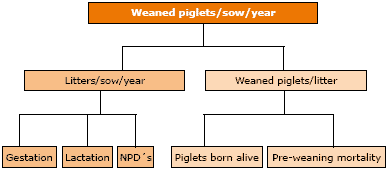 |
| Figure 1:Breeding herd efficiency |
What is behind all this?
Ca-Metabolism & Regulation
As mentioned above the serum Ca level is regulated by hormones and has to be kept in narrow ranges (2.3-2.8 mmol/l in sows) (KOLB, 1989). Hormones involved in the control mechanism are parathyroid hormone and calcitonin as well as 1.25-(OH)2-Vit. D (active form of Vitamin D3). When plasma Ca concentration declines, parathyroid hormone and 1.25- (OH)2-Vit. D are activated and Ca-resorption via the kidneys, Ca- adsorption from the digestive tract as well as bone mobilization are increasing.
Since there is a permanent “over-consumption” of Ca during gestation (because of a low demand) this mechanism is not trained- the parathyroid control mechanism is slowed down and cannot react in time on the changed/increased Ca demands peri-farrowing. Consequences are declining Ca blood levels which can not be balanced in time and in the end Ca is missing for the contraction of muscles and a deficit in Ca blocks the release of oxytocin, which is important for muscle contraction too. Declining Ca levels delay the farrowing process and in the end the livability of the piglets is decreasing and/or the piglets die prematurely.
Urine Acidification & Regulation
Balancing the acid-base-balance and regulating the blood pH at around 7.42 (reference value for pigs) (BEKER, 1999) is important for the maintenance of all vital functions of the body.
The blood pH is regulated via 3 mechanisms:
• Binding and release of H+ via puffer systems
• Regulating the partial pressure of CO2 via respiration
• Regulating the renal H+ and HCO3- excretion
Let’s have a closer look on regulating the blood pH via renal excretion, because this mechanism is relevant for the mode of action of Biomin® pHD.
Excreta pH is a function of the acid-base balance of the feed and balancing for anions and cations influences the acid-base balance of the body. Increasing anions in the diet lead to an acidic stress of the organism. 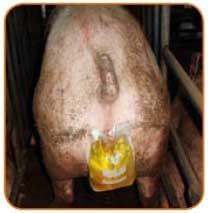
Picture 1:Urine sampling
| Balancing for anions and cations The acid-base balance of feed can be estimated with the anion-cation-balance (ACB) concept, for which there are several equations available. Basically it is a simplified way of expressing the dietary cation-anion difference in the diet, whereby cations have an alkalising and anions and acidifying effect. An equation to calculate the ACB for sow diets, which has been shown to be strongly related to sow urinary pH, was established by BEKER (1999). The factors in the equation represent the differences in absorption and atomic weight of minerals: ACB (mmol/kg DM) = 49.9*Ca + 82.3*Mg + 43.5*Na + 25.6*K – 59*P – 13*(Met+Cys) – 28.2*Cl As shown above the equation is based on certain minerals and amino acids. Thus the ACB for different raw materials or whole diets can be calculated from their nutrient composition. Therefore, by adding up the ACBs of the individual dietary components, one can calculate the ACB of the entire diet. Conventional sow diets have a range of +200 to +600mmol/kg. |
Therefore to lower the urinary pH to below 6.5 the ACB of the diet would have to be lowered quite considerably. The challenge is in lowering cations and/or increasing anions. Especially the calcium-phosphor-ratio is an important parameter in stability of the skeletal system and not less important is an adequate sodium and magnesia supply.
Therefore cations cannot be easily excluded from lactating sow diets and secondly via variation of raw materials only a minor manipulation of the ACB value of the diet is possible. Therefore it is highly recommended to use urine acidifying substances wherever it makes sense to acidify the urine (e.g. farrowing and insemination).
Depending on extent of acidic stress metabolic acidosis is the immediate consequence. The body tries to compensate acidosis via increasing H+ excretion and increasing readsorption of HCO3-, which acidifies the urine.
Furthermore it is reported that an acidic stress of the acid-basebalance lead to a net-excretion of calcium from the body by increasing renal Ca excretion (RÖCKER, 2006). The body tries to compensate this lack via an increased mobilization of Ca from the bones as the biggest Ca storage of the body and, at the same time, the body tries to puffer the blood pH via increasing Ca resorption (regulated by parathyroid hormone and 1.25- (OH)2-Vit. D). Resulting in increasing Ca blood levels.
It is assumed that feeding anionic diets train parathyroid hormone and 1.25-(OH)2-Vit. D mechanisms. Meaning in times of increased demands of Ca, particular pre-farrowing, this hormonal mechanisms can act faster and more efficient (HORST et al. 1994).
These literature surveys confirm the already proven effects of feeding Biomin® pHD (see Table 2 and 3) and opens new applications for the future.
| Table 2: Urine pH in response to feeding Biomin® pHD (Cyprus, 2006) |
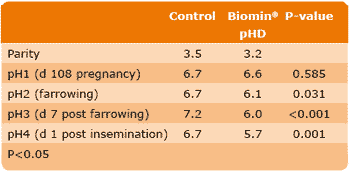 |
| Table 3:Urine pH in response to feeding Biomin® pHD (Philippines, 2006) |
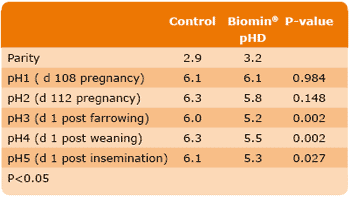 |
Based on these new facts, a trial was carried out under farm conditions in Australia and the results are promising.
Trial
The trial was conducted in a climate controlled breeder unit in Southern Queensland in January 2007. The control group was fed conventionally and the trial group received additionally 0.5% Biomin® pHD in the feed for 10 days pre-farrowing until mating. Main focus was on farrowing performance.
Results and Discussion
The addition of Biomin® pHD pre-farrowing had a significant response in reducing still births from 1.15 down to 0.73 piglets per litter (P>0.05)
Furthermore it was suggested that the addition of Biomin® pHD eased farrowing and reduced the number of farrow assistance as well as reduced the number of discharges post lactation.
| Table 4:Farrowing performance (Australia, 2007) |
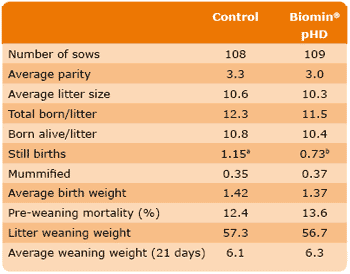 |
Conclusion
In consideration of the facts mentioned above the mode of action of Biomin® pHD can be extended in terms of improving piglets born alive due to its supposed effect on the acid-base-balance of the body.
Nevertheless main focus is still on supporting the natural defence mechanism - via preventing the invasion, multiplication and adhesion of pathogenic bacteria to the urogenital tract of the sow.
This effect is based on two strategies:
• Creating unfavourable conditions for the bacteria and inhibiting their growth by a blend of an inorganic acid and anionic substances
• Binding pathogenic bacteria and inhibiting their adherence to the urinary tract cell walls by Proanthocyanidins (PAC´s) contained in Cranberries.
Consequently the addition of Biomin® pHD increases productivity of the herd due to its effect against UTI´s and related Metritis problems and due to its supposed effect on piglets born alive.
Literature
Goeff, J.P. and Horst, R.L. (1998): Use of hydrochloric acid as a source of anions for prevention of milk fever. J. Dairy Science. 81, 2874-2880.
Block, E. (1994): Manipulation of dieatary cation-anion difference on nutritionally related production diseases, productivity and metabolic responses of dairy cows. J. Dairy Science. 77, 1437-1450.
Block, E. (1984): Manipulating dietary anions and cations for prepartum dairy cows to reduce incidence of milk fever. J. Dairy Science. 67, 2939-2948
Kolb, E. (1989): Lehrbuch der Physiologie der Haustiere. Gustav Fischer Verlag, Stuttgart, New York
Beker, S. (1999): Einstellung des Harn pH-Wertes bei Sauen. München: Diss. Ludwig-Maximilian-Universität
Röcker, B. (2006): Untersuchung zur Acidierung des Harns. Hannover: Diss. Tierärztliche Hochschule Hannover
| About the author | |
 | Name: Barbara Rüel Position: Product Manager Education: 1999-2004 University of Natural Resources and Applied Life Sciences, Vienna, Spec. Agricultural- Animal Nutrition Master thesis: The effect of bovine lactoferrin on severity of diarrhea and growth performance in weaned piglets. |







